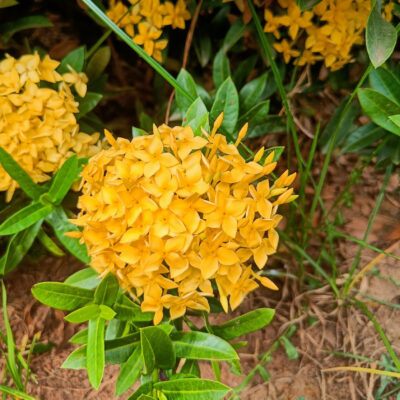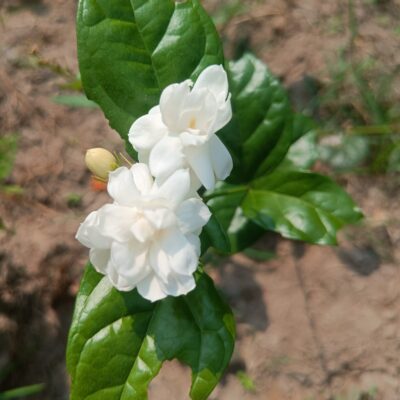Description
Hibiscus sandal (sandal sembaruthi)
A Hibiscus sandal sembaruthi plant will give any backyard garden unfathomable beauty because of the variety of colors it produces and the tempting scents it emits. Whether inside the house or outside in the garden, hibiscus flowers give a home a sense of rightness and elegance.
Common Name: China Rose, Rose-of-China, Shoeblackplant, Hawaiian Hibiscus, Tropical Hibiscus. We have wide range of gardening plants on our website.
Subfamily: Malvoideae
Tribe: Hibisceae
Genus: Hibiscus
H. rosa-sinensis is the species.
The name of the flowering plant is Hibiscus rosa-Sinensis. It is a cooling, sweet, astringent plant that calms sensitive tissues, stops bleeding, and eases spasms. The flowers have cooling, emollient, demulcent, emmenagogue, and aphrodisiac properties. To cure excessive and painful menstruation, cystitis, venereal infections, febrile illnesses, bronchial catarrh, and coughs, and to encourage hair development, they are used internally.
Advantages
Shampoos, hair wash powders, and oral pills that promote hair growth all contain hibiscus flowers and leaves. It is an Ayurvedic herb used to cure bleeding piles, emaciation, dysmenorrhea, and alopecia. It also strengthens hair roots and increases heart muscle power.
Benefits
The flower’s juice is utilized as mascara and shoe-blacking. The petals are used to create the dye. The stems can be used to produce fiber of high grade. The fibers can reach lengths of up to 3 meters in warm subtropical regions, but in Britain, they are probably much shorter. Fiber is used to make paper, nets, and coarse textiles.
theorganicpot is your qualified, dependable, and floral partner for one-stop shopping for high-quality flower items. The procurement, packing, and international air freight shipping of premium flowers, plants, and accessories is the sole focus of theorganicpot
Method of export
The acquisition, packaging, and international air freight shipment of premium plants (and freshly cut flowers) is the only emphasis of our export operations. We have provided top-notch young plants to numerous international wholesalers, farmers, and merchants. Whether you’re seeking tissue culture plants, seeds, bulbs, rooted or unrooted cuttings, etc., you can receive them from us at any time, anywhere.
We specialize in air cargo and maritime shipping. As a result, we created unique packaging that was created specifically for these delicate plants.
Our excellence
theorganicpot can give you accurate information regarding availability, new kinds, and growing methods due to our regular and direct contact with the producers. Additionally, we assist you in organizing your yearly growing strategy.
Because of our tight relationships with numerous growers, there are few lines and a very diverse selection accessible. We can manage international air freight shipments because our company is registered as a known shipper. The best freight prices are provided to our clients as a consequence of tight collaboration with different forwarders.
Steps to take when planting
The main goal of trimming is to guarantee that you will have a stunning hibiscus for your landscape. Therefore, prune the longer branches by about a third and eliminate any dead, weak, or strangely shaped branches. The flowering stage of the hibiscus flower necessitates a lot of water. In warm weather, your hibiscus plant will require daily watering. Your hibiscus needs significantly less water when the weather cools, and too much water can harm it. Water your hibiscus in the winter only when the soil seems completely dry to the touch.
Conditions – When caring for a hibiscus, keep in mind that it cannot withstand temperatures below 32 F and blooms best in temperatures between 60 and 90 F (16 and 32 C) (0 C.). Your hibiscus plant can be left outside during the summer, but you should bring it inside once the temperature drops below freezing.
Watering – Hibiscus need lots of water when plants are blooming, therefore watering is important. In warm weather, your hibiscus will require daily watering. Your hibiscus needs significantly less water when the weather cools, and too much water can harm it. Water your hibiscus in the winter only when the soil seems completely dry to the touch.
Winter Care – If the temperature falls below 50 degrees in your location, bring potted hibiscus inside. Put the pot close to a south-facing window that gets direct sunlight all day. After bringing a plant indoors, some leaf drop is typical. Reduce watering if the plant loses all of its leaves, but don’t let the soil get completely dry. The plant will produce a new flush of growth after which you may resume fertilizing and normal watering. Winter is a semi-dormant time for both indoor and outdoor plants, so they only require watering when the soil feels dry. Outdoor tropical hibiscus benefits from having a 2- to 4-inch layer of mulch applied because it insulates the soil and helps the plant withstand brief bouts of cold. We have some best indoor plants available and you can buy plants online.
Fertilizing: For a hibiscus plant to blossom successfully, it needs a lot of nutrients. Use a heavy potassium fertilizer in the summer. Use a delayed-release fertilizer once a month, a diluted liquid fertilizer once a week, or amend the soil with rich potassium compost. You don’t need to fertilize at all during the winter.
The spring season is the ideal time to cultivate hibiscus. Twelve weeks before the last frost, you can start them indoors if you’re starting from seed. Otherwise, hold off on starting them till the temperature has risen over 60°F at night, and pick a sunny area. Make sure there’s enough room for air to circulate and expand between each one. Provide abundant moisture while planting, and maintain a consistent moisture level throughout the summer.
Maintenance
Tropical hibiscus cultivars make wonderful indoor plants that, with the right care, can add color to your home year-round. They’ll require a window that faces south or is otherwise bright and sunny. They will flourish if you provide a well-draining, loamy potting soil mixture. Because they are susceptible to temperature changes, keep them away from draughty locations and air conditioning and heating vents.
Hibiscus are commonly grown in pots, which allow gardeners to control the light and temperature as the season’s change or bring the plants inside when it gets too cold. To help control moisture retention, pick a container with good drainage and, if at all feasible, one made of a porous substance. When they are a little root-bound, they also tend to blossom more. So don’t put them in very big pots. For a few years, give them just enough room to flourish. You can fill your garden with our flowering plants on our website. theorganicpot have the best collection of nursery plants.




Reviews
There are no reviews yet.